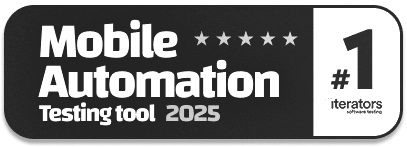Top 20 SaaS Testing Tools for 2025
|
|
SaaS testing tools have become the backbone of efficient and scalable software quality assurance. In an era where CI/CD pipelines are becoming widespread, cloud-based testing platforms provide availability, scalability, and intelligence that conventional tools often miss. However, in 2025, a new wave of SaaS testing tools featuring AI-powered testing, codeless automation, real device clouds, and smarter test orchestration, among others, is at the forefront.
What Are SaaS Testing Tools?
SaaS testing tools are web-based platforms that streamline performing and managing various software tests, including functional, performance, security, usability, and compatibility, without requiring on-premise infrastructure. They provide pay-per-use scalability in the cloud, seamless integration, and low-code/no-code capabilities for non-technical users. They support:
- Continuous testing in DevOps pipelines.
- Cross-browser and real-device testing
- AI-based visual testing and test generation.
- Manual test management and reporting.
Why SaaS Testing Tools Matter in 2025?
2025 is changing the principles of software testing. With development teams deploying updates faster than ever, juggling intricate tech stacks, and building for a global audience, old-school testing methods simply can’t keep up. That’s where SaaS testing tools step in, smarter, faster, and built for the cloud. These AI-driven, collaboration-ready platforms are reshaping how quality assurance fits into the modern software lifecycle.
- Faster Test Execution: Execute the tests in no time through the cloud, with the ability to control parallel execution and CI/CD integrations to gain several orders of magnitude reduction in testing time. This enables quicker feedback loops and faster product releases.
- Self-Healing Test Suites: AI-driven self-healing capabilities automatically repair broken tests due to UI modifications. It minimizes manual maintenance and improves test stability.
- Parallel Execution Across Cloud Devices: These tools give teams a scalable test infrastructure using actual devices and browsers that can execute thousands of tests at the same time.
Top 20 SaaS Testing Tools
Let’s explore the top 20 SaaS testing tools for 2025.
testRigor
testRigor is a fully cloud-based, end-to-end testing tool powered by generative AI. This AI agent supports different types of testing, such as native desktop, web, mobile, API, visual, exploratory, AI features, mainframe, graph, Flutter apps, accessibility testing, and many more, using just plain English. The best part is that it’s a codeless solution, which means you can write the tests from the start using normal English commands.
Do complex, elaborate scenarios in almost plain English easily: 2FA, file, email, SMS, phone call, tables, visual, audio, QR code, geolocation, accessibility and much more. The tool integrates seamlessly with other tools like TestRail, Jira, Zephyr, Oracle, Postgres, CI/CD tools like Jenkins, AWS, GitLab, etc.
From the description of a particular test case, feature, or app, you can generate test cases in plain English. testRigor has its record-and-playback extension that records the test cases and the test scripts in plain English to better facilitate codeless testing. Read: All-Inclusive Guide to Test Case Creation in testRigor.
In addition, you can use AI to test AI, LLMs, chatbots, graphs, user sentiments: positive/negative statements, true/false statements, images, and many more.
Rainforest QA
Rainforest QA is a cloud-based testing platform that has an interesting hybrid approach, combining automated testing with crowdsourced manual testing. It’s built for total no-code, intended for use by product managers, QA analysts, and non-technical users to write and manage functional tests using simple English instructions. Tests can be run either by bots or a worldwide pool of human testers, so it is well-suited for both rapid automation and real-world usability feedback.
One of Rainforest QA’s main strengths is its speed of running tests on demand and delivering results in minutes. It integrates easily into CI/CD pipelines, enabling continuous testing without writing scripts. It also includes rich reporting, test versioning, and reproducible bug reports, complete with screenshots and video logs. Despite its strengths, Rainforest QA has a few limitations. Its testing capabilities are mainly limited to web applications, with no support for mobile or API testing. Overall, it’s a good match for agile teams seeking fast, trustworthy feedback with low setup and technical overhead.
Reflect
Reflect is a modern no-code test automation tool for web applications that allows you to build, manage, and run tests quickly and intuitively, directly in the browser. Users can create test flows by simply using their app, and Reflect automatically creates powerful, reusable test scripts from those actions.
Reflect supports cross-browser testing, CI/CD integration, and test scheduling, making it suitable for continuous deployment environments. Its intelligent element selectors keep your tests stable when the UI changes slightly. Reflect also offers video replays, screenshot comparisons, and detailed logs to ease debugging. However, Reflect can be used only with web application UI testing, and no mobile app/API testing is supported. While this is great for basic workflows, it doesn’t have the advanced customization, logic handling, or conditional branching required for complex test workflows. Overall, it’s a great match for startups and agile teams that want to accelerate their release cycle without investing heavily in classical automation frameworks.
Ghost Inspector
Ghost Inspector is a no-code, cloud-based test automation tool that helps teams create, run, and manage browser-based UI tests on websites and web applications. It enables users to record tests live via a Chrome extension, capturing actions such as clicks, form submissions, and navigation. It also supports visual regression testing. Tests can be run on-demand, scheduled, or hooked into CI/CD pipelines and easily integrated into agile development workflows. Ghost Inspector also offers video recordings of tests, detailed logs, and automatic fail alerts, which makes debugging easier and improves team collaboration.
However, Ghost Inspector is primarily focused on front-end/browser testing, so it’s not ideal for more complex backend or API testing. Additionally, while great for small to mid-sized teams, it may lack advanced test management features or AI-based smart selectors offered by newer tools. With its browser-based focus and ease of use, Ghost Inspector streamlines front-end test automation without the complexity of traditional frameworks.
Regtest
Regtest is a cloud-based visual regression testing tool that captures and compares screenshots across test runs to find unintended UI changes for your team. Through pixel-level difference detection, it is best suited for detecting layout shifts or styling or rendering bugs that may not appear in functional tests. Regtest runs purely in the browser, allowing users to configure tests by dragging written tests around, uploading screenshots, and viewing visual diffs without ever provisioning any infrastructure.
The tool has a light footprint and is easy to use, which makes it useful for designers, front-end developers, and QA teams in need of fast visual feedback. Baseline management, visual diff views, and automated test runs, particularly when tied into CI/CD pipelines. It is simple to learn and implement and, therefore, gets adopted faster and yields results quickly in agile workspaces. However, Regtest is limited to basic screenshot comparison and does not include AI-powered analysis, cross-browser testing, or support for mobile or responsive testing. It may also lack detailed integration options or advanced collaboration features.
Autify
Autify is a no-code, AI-powered test automation tool that enables teams to effortlessly generate and maintain web and mobile app tests. Autify enables users to build tests by simply using the application in a browser and then automatically recording actions as test steps.
It supports cross-browser testing, parallel execution, and CI/CD integration, making it a good fit for agile and DevOps workflows. It also supports team collaboration, detailed test reports, and integration with Slack, GitHub, and Jira, among other products. It’s ideal for teams with minimal coding knowledge who are looking to scale test automation rapidly.
Autify has its shortcomings, at this stage, it only supports a few browsers and devices and might require workarounds for complex test logic or advanced validations. It is also relatively newer compared to existing automation frameworks, which can limit the degree of customization and flexibility available.
Waldo
Waldo is a no-code mobile test automation platform designed for iOS and Android apps. Teams can write and run end-to-end tests without writing a single line of code. Waldo records tests by simulating browser-based interactions with your app and builds powerful test scripts that stay intact even as your UI changes. It’s designed for product teams, mobile developers, and QA engineers.
Waldo seamlessly integrates into CI/CD pipelines, letting you run tests whenever a new build is created. It also offers detailed reports, video replays, and error tracing to help you quickly identify issues. However, Waldo is currently focused solely on mobile apps, so it doesn’t support web or API testing. While it’s user-friendly and powerful, teams with complex logic-based test scenarios may find its no-code interface somewhat restrictive.
Apica
Apica is a SaaS-based performance testing and synthetic monitoring platform for organizations to test the scalability, performance, and uptime of web applications, APIs, and services. It allows you to simulate real user traffic from a global network of test nodes, which helps in performing load testing and performance benchmarking with realistic network conditions. Apica offers both protocol-level testing and browser-based testing.
The platform integrates with CI/CD pipelines, DevOps tools, and monitoring solutions like Grafana and Prometheus. Synthetic monitoring means the service continuously tests application availability and performance, even when there are no active users. Enterprises commonly use Apica to verify digital experience and application health across geographies.
However, Apica’s enterprise orientation and pricing could potentially pose problems for smaller teams or startups. It might also take some technical know-how to properly take advantage of its advanced configuration and custom scripting options that make it somewhat unsuitable for non-techies or everyone searching for a plug-and-play solution instead.
StormForge
StormForge is a cloud-native performance and Kubernetes optimization platform that empowers engineering teams to test, monitor, and optimize application performance and infrastructure efficiency. The combination of load testing with machine-learning-based performance tuning allows you to load realistic traffic over K8s instances and pass a cost-effective configuration for workloads. StormForge’s Experimentation platform automates performance testing scenarios and recommends resource adjustments based on performance properties like latency, throughput, and CPU/memory usage.
It works natively with CI/CD pipelines. Its Kubernetes-native approach can be especially helpful for modern microservices-based apps hosted on clusters. StormForge also offers detailed visualizations and comparative reports.
At the same time, while StormForge is highly specialized, it may not be suited for teams whose infrastructure isn’t running in containers. On top of that, its advanced ML optimization features might have a learning curve and might be overkill for simpler use cases for performance testing that do not require tuning infrastructure.
vRest
vREST is a SaaS-based automated testing platform. It enables users to create, execute, and manage automated API test cases with ease, without having to write complex scripts. Some of vREST features include test case grouping, environment management, test data parameterization, and detailed reporting, etc.
One of the features it also supports is mock server generation, which facilitates the testing of APIs in isolation before the last backend components are written. vREST can also be integrated with CI/CD tools such as Jenkins, GitHub actions, GitLab CI, etc. The intuitive browser-based user interface is especially useful for QA engineers and developers.
But vREST comes with limitations: it is only designed for REST APIs, and does not have native support for GraphQL or SOAP. Karate also falls short in some aspects at the advanced end of CI/CD, like load testing or performance testing. Performance-wise, large-scale enterprise testing is definitely where dedicated tools are required (ReadyAPI, for example, or Postman Enterprise).
AWS Device Farm
AWS Device Farm is a cloud-based testing service provided by Amazon that enables the QA team to test Android, iOS, and mobile web apps on various physical devices hosted in the cloud. It allows for manual testing (live interaction with the devices) and automated testing with popular frameworks including Appium, Espresso, XCUITest, Calabash, and more. It helps in detecting problems such as inconsistency in UI, crashes, and performance bottlenecks on various devices, OS versions, and screen sizes.
Test outputs consist of logs, screenshots, recordings, and performance data, which help debug and optimize the apps effectively. AWS Device Farm can integrate with CI/CD pipelines, allowing automated tests to be executed during the development process. It is great for any team that wants to make sure broad device compatibility without the overhead of maintaining a device lab within the organization. However, it may become a bit pricey for high test volumes and may not have the options you see in some modern all-in-one testing platforms for advanced test management and analytics.
Postman (Enterprise)
Postman is a powerful API testing tool that allows developers to develop, test, document, and monitor APIs across a collaborative, cloud-based work area. It simplifies the creation of automated API tests in a low-code environment with JavaScript scripting support, environment variable use, data-driven testing support, and the ability to do request chaining. The ability to easily simulate complex API workflows with Postman validates response codes, headers, and payloads, catching issues early in the development cycle.
Postman enables cross-functional teams with Enterprise-level features such as shared workspaces, role-based access control, audit logs, and integrations with CI/CD tools such as Jenkins, GitHub Actions, and Azure DevOps for continual testing. It also features mock servers, monitoring, and version control to test APIs through various stages of development. Use the Insights section to generate detailed test reports and console logs to help speed up failure identification and debugging processes. However, Postman does not perform testing at the UI level, nor does it offer end-to-end functional testing, which is why it is commonly used in conjunction with other testing tools for full coverage.
Assertible
Assertible is a cloud-based API testing and monitoring platform that helps teams test their web services are reliable and correct. It lets you write automated tests for RESTful APIs from a simple, low-code interface, with support for asserting response status codes, headers, and JSON payloads. Assertible is very good for testing after a deployment, when tests are automatically triggered after a code deployment, helping catch problems in production environments.
It integrates with CI/CD pipeline tools like GitHub, Jenkins, and Slack, and also provides a scheduled monitoring option. It ensures that APIs are monitored round the clock. Testing variables, environments, and automatic failure alerts make it useful for both development teams and operations teams. Assertible is particularly useful for continuous monitoring and health checks of your critical APIs. However, it’s focused solely on API testing, so it doesn’t support UI, mobile, or performance testing and may feel limited for teams needing a broader testing solution. Read: Understanding Test Monitoring and Test Control.
k6 Cloud (Grafana Labs)
k6 Cloud, from Grafana Labs, is a powerful load and performance testing platform that enables teams to test the scalability and reliability of web applications and APIs in the cloud. K6 Cloud is the cloud version of the open-source K6 CLI tool, with additional features like real-time dashboards, test scheduling, team collaboration, and result visualization.
Users write tests in JavaScript, simulating real-world user traffic and other complex scenarios, with high concurrency. k6 Cloud offers granular performance metrics (response times, error rates, thresholds, etc.) to allow teams to diagnose bottlenecks under heavy load. It integrates seamlessly with CI/CD pipelines and tools like Grafana, allowing performance testing to become part of continuous delivery. However, k6 Cloud is only for performance and load testing. It does not support functional UI testing, mobile app testing, or visual validation. Also, writing complex tests may necessitate JavaScript knowledge, which is a challenge for non-technical testers.
BlazeMeter (Perforce)
BlazeMeter (now owned by Perforce) is an all-inclusive cloud performance, load, and API testing platform that simulates real traffic in a scalable manner. It supports open-source tools like Apache JMeter, Gatling, Selenium, and Locust, so teams can reuse existing test scripts and run them in the cloud without deployment. BlazeMeter provides solid monitoring and reporting: real-time reports, test dashboards, and correlation analysis that help teams locate performance bottlenecks and system limits under stress.
It works well with continuous integration and delivery pipelines. BlazeMeter offers functional API testing, along with mock services and test data management. But it is on this part that BlazeMeter can be complicated for beginners, mostly while setting up advanced test cases. Also, while it does support UI testing, its real power is intended for load and performance testing, and though it has some newer codeless or visual test creation features, as an older tool, it may not hold up to some newer platforms.
LoadNinja
LoadNinja is a cloud-based load and performance testing tool that allows teams to perform web application tests using real browsers instead of virtual users for better accuracy. It uses its test recorder for scriptless test creation, enabling testers to create and replay performance tests without needing to write any code. LoadNinja also delivers real-time debugging, detailed analytics, and browser-based metrics that help teams quickly spot client-side performance problems, including slow rendering, for example, or JavaScript errors.
It works with CI/CD pipelines and integrates with tools such as Jenkins. One of its key strengths is the ability to test at scale with thousands of concurrent users while capturing both frontend and backend performance data. However, LoadNinja caters only to web apps, so it does not support mobile or API testing. As mentioned above, the scriptless approach is similar to usage for ease of function. However, it may lack the flexibility and control that more technical users need for complex test scenarios.
Loader.io
Loader.io is a cloud-based load testing service that allows developers and QA teams to test the performance and scalability of their web applications and APIs. It enables users to simulate thousands of concurrent connections to a targeted host, which helps identify bottlenecks, crashes, or slow response times under stress. Loader.io is super easy to get started with. You just have to verify your domain, set test parameters, and start testing within minutes.
Loader.io supports such basic test types as the GET, POST, and PUT requests and offers real-time performance metrics, including response time, throughput, and error rates. Additionally, it can be integrated with CI/CD pipelines so teams can automate load testing as part of their deployment workflows. However, it has limitations on advanced functionality; it does not support scripting complex test flows, simulating user behavior, or monitoring detailed transactions. Loader. io works best for startups, small teams, or developers looking for fast, lightweight performance checks.
Detectify
Detectify is a cloud-based automated security testing tool that scans web applications for vulnerabilities, misconfigurations and exposed assets with a database of known exploits that is continuously updated. It crowdsources findings from ethical hackers, which are then automated into Detectify’s scanning engine. It provides detailed, actionable reports on things like XSS, SQL injection, insecure headers, and outdated software. Detectify can be configured quickly, integrates with CI/CD pipelines, and offers continuous scanning of staging and production environments. It also provides domain monitoring, assisting teams to identify shadow IT and misconfigured DNS records.
However, Detectify is focused on dynamic (DAST) and surface-level testing, meaning it may not detect deeply embedded or logic-based vulnerabilities. It also lacks manual testing or penetration testing capabilities and may generate false positives, requiring human review. For teams needing deeper analysis or compliance-specific reports, complementary tools or manual assessments may be necessary.
Intruder
Intruder is a cloud-based vulnerability testing platform for finding and fixing security weaknesses in web applications, systems, and networks. It provides an intuitive interface and a powerful scanning engine that checks for thousands of known vulnerabilities, including misconfigurations, exposed services, outdated software, and CVEs. Intruder passively scans for vulnerabilities, alerting teams as new assets are potentially under threat.
It works with Slack, Jira, AWS, and CI/CD tools, making it a fit for the modern DevSecOps workflow. Intruder also puts vulnerabilities into threat context and business impact, making it easier for teams to focus on what matters most. With its simplicity, automation, and continuous scanning features, this solution is well-suited for small to mid-sized organizations looking for trusted security testing without an enterprise solution’s overhead.
However, Intruder is primarily focused on external perimeter and infrastructure scanning and may lack advanced features for deep application-layer testing, such as logic flaws or authenticated vulnerability assessments. It also doesn’t include manual penetration testing, so it’s best used alongside other tools for comprehensive security coverage.
StackHawk
Stackhawk is a cloud-based dynamic application security testing (DAST) platform for modern development teams to discover and remediate vulnerabilities. Using an automated, developer-friendly approach, it scans running applications (APIs, web apps and microservices) for common security issues such as SQL injection, XSS and misconfigurations. StackHawk integrates with CI/CD tools and gives actionable security insights back to developers in the form of easy-to-read reports and debugging tips.
It supports OpenAPI, GraphQL, and SOAP specs, which makes it effective for scanning RESTful as well as complex APIs. StackHawk emphasizes shift-left security, enabling teams to incorporate automated security testing into their workflows without requiring deep security expertise. Its alerting and collaboration features make it a good fit for agile and DevSecOps environments. Read: The Role of QA in DevSecOps.
However, StackHawk is focused specifically on DAST and doesn’t provide static code analysis (SAST) or manual penetration testing capabilities. It also requires a running instance of the application to perform scans, which may limit its usefulness in early development stages or for legacy apps with complex deployment needs.
Conclusion
In 2025, SaaS testing tools are a requirement, not just a choice, for agile, quality-focused development teams. These platforms empower teams to test smarter and faster with features like AI-driven automation, real device cloud testing, and CI/CD integration. There is a tool for every need and size team, either for UI, API, performance or security. The evolution of software development has brought SaaS testing tools to the forefront of this revolution, rendering QA increasingly efficient, intelligent, and accessible.
| Achieve More Than 90% Test Automation | |
| Step by Step Walkthroughs and Help | |
| 14 Day Free Trial, Cancel Anytime |












